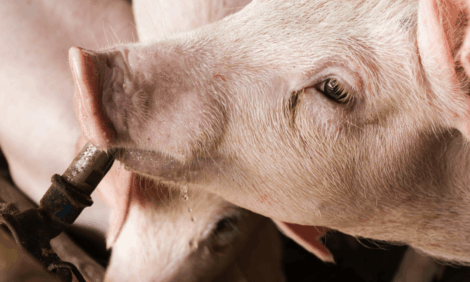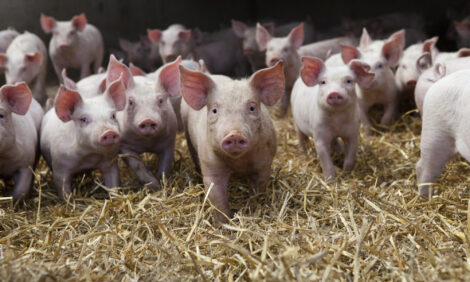



Ractopamine Increases Protein Deposition in the Carcass
Inclusion of 5mg/kg of ractopamine hydrochloride improved protein deposition, according to K.A. Ross and co-authors in the 2008 Annual Research Report from the Prairie Swine Centre.Summary
A comparative slaughter experiment utilizing 120 barrows was conducted to measure growth performance and nutrient retention in the carcass when either 0, 5 or 10 mg/kg ractopamine hydrochloride was added to the diet at three levels of dietary lysine. Therefore, there were nine different dietary treatments (3 ractopamine × 3 lysine:DE ratios). Growth performance and nutrient retention in the carcass were determined.
Ractopamine did not affect ADG, ADFI or the gain to feed ratio (P>0.10). With increasing lysine G:F improved (0.35, 0.35 and 0.39; P<0.05), ADG and ADFI were unaffected (P>0.10). Protein deposition rates tended to increase (162.1, 185.4 and 189.2 g/d with 0, 5 and 10 mg/kg ractopamine; P<0.11) and lipid deposition rates tended to decrease (619.8, 461.6 and 542.3 g/d) with 0, 5 and 10 mg/kg ractopamine, respectively, (P<0.10).
* “Inclusion of 5 mg/kg ractopamine hydrochloride improved protein deposition” |
|
|
Introduction
Ractopamine hydrochloride, (RAC) is a ß-adrenergic agonist that belongs to the class of chemicals that includes, for example, clenbuterol. Ractopamine hydrochloride is the active ingredient in Paylean®, widely used in the swine industry due to benefits such as increased growth rate, feed efficiency and carcass lean deposition. Prairie Swine Center researchers (Patience et al. 2006 PSCI Annual Report) have shown improvements in growth performance and carcass quality when RAC was included in the diet at 5 mg/kg.
The following experiment is part of a larger series of experiments examining the potential to utilise Paylean as a tool to reduce the environmental impact of pork production.
The authors hypothesised that including Paylean in the diet would improve nitrogen (N) retention, thus decrease N output in the urine and faeces of finishing swine. The specific objective in the experiment reported herein was to examine the effect of Paylean, added to the diet to supply five or 10 mg/kg RAC, on carcass nutrient deposition.
Materials and Methods
A growth experiment was conducted which compared nine different treatments. These included Paylean added to the diet to supply 0, 5 or 10 g/tonne RAC × three levels of dietary lysine (1.75 g/Mcal, 2.25 g/Mcal) and 2.75 g standardised ileal digestible lysine/Mcal DE. Additionally, because it is known that the efficacy of Paylean reaches an optimum and then decreases, two slaughter weights were included as an additional factor.
Diets were based on wheat, barley and soybean meal and also contained canola oil, vitamin/mineral premix, synthetic amino acids and Paylean. All diets were formulated to contain 3,300 kcal DE/kg and formulated to meet or exceed the nutrient requirements of the finisher pig (NRC, 1998).
The experiment began when the barrows reached 95 ± 3 kg bodyweight and ended when they reached a final weight of either of 108 or 120 ± 3 kg. Pigs were euthanised by captive bolt stunning, followed by exsanguination; all blood was collected and returned to the carcass. The carcass was split down the midline from the groin to the chest cavity and the entire gastrointestinal tract (GIT) was removed, emptied of digesta and patted dry. The gall and urinary bladders were also drained of contents. The emptied GIT was then returned to the carcass and an empty body weight recorded. Carcasses were ground, freeze-dried and subsequently analyzed for moisture, N, fat and ash (indicative of total mineral content).
Results and Discussion
Paylean had no effect on ADG, ADFI or G:F (Table 2; P > 0.10). Lysine had no effect on ADG or ADFI (P>0.10). However, G:F increased with high dietary lysine concentration (P<0.05). ADFI was higher in the 120 kg slaughter weight treatment (P<0.05) when compared to the 108 kg slaughter weight. Slaughter weight did not affect ADG or G:F (P>0.05).
Paylean tended to increase protein deposition in the carcass (25 g/d increase, 0 versus 10 mg/kg RAC; P<0.12; Table 3), increased water deposition rate (P<0.05), and tended to reduce fat deposition rate (P<0.10; Table 3). The lowest fat deposition was observed with the 5 mg/kg RAC level (620, 462, and 542 g/d fat deposition for 0, 5 and 10 mg RAC/kg feed). Protein, but not fat deposition rate increased in response to lysine (P<0.05). The 120 kg slaughter weight pigs had increased deposition rates of protein, fat and water (P<0.05) compared to the barrows slaughtered at 108 kg however, there was no RAC by slaughter weight interaction (P>0.10).
The lack of a growth response to Paylean in this experiment is contrary to the preponderance of previous research. The response to Paylean diminishes after it has been fed for about 28 days. The average time on Paylean in these experiments was 17 and 9 days for the 120 and 108 kg slaughter groups, respectively, therefore a growth response was expected.
A response to increasing dietary lysine:DE ratio was observed. Pigs received 18.9, 23.6 and 25.8 g SID lysine per day, which exceeds NRC (1998) lysine requirements. However, present day pigs may require more lysine than the NRC (1998) recommendations. Additionally, because of the improvement in lean growth with Paylean, the finishing pig’s requirement for lysine increases when Paylean is added to the diet. However, if lysine was limiting the response to Paylean, one would expect to see a lysine by Paylean interaction due to a greater response to Paylean at the higher lysine levels. This, however, was not observed (Table 2).
It is interesting that even though no growth response to Paylean was observed, there was an increase in protein and water and a decrease in lipid deposition when Paylean was added to the diet. Overall, this would be expected to result in a leaner carcass. Moreover, the rate of protein deposition (g/d) was higher for the pigs slaughtered at 120 than at 108 kg (P<0.05). The opposite was seen with lipid deposition (P<0.05). Lean tissue is approximately 80 per cent water, while adipose tissue contains only about 15 per cent water, thus we expect increased water deposition to accompany the higher protein deposition. It should be noted that the baseline protein deposition rates in these pigs was high. This can be attributed to a multitude of factors including genetics, diet, environment or due to the slaughter process used in this experiment (entire carcass was ground). Regardless, even at the 5 mg/kg level, RAC improved protein deposition above the baseline.
Implications
Although there was no response in growth rate, 5 mg/kg RAC improved protein deposition. The response to RAC may not be evident if growth rate is the only criteria measured. Lysine requirements may be higher than recommended when Paylean is used in a herd with high rate of protein deposition.
Acknowledgements
Programme funding is provided by Sask Pork, Alberta Pork, Manitoba Pork Council and the Saskatchewan Agricultural Development Fund. Project funds were provided by Elanco Animal Health.



May 2010








